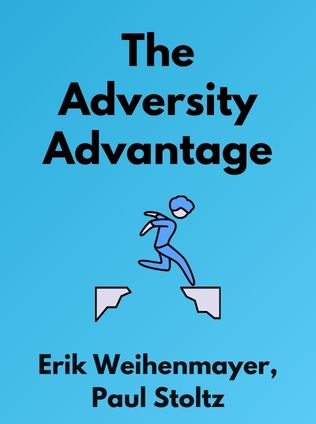
The Adversity Advantage
Turning Everyday Struggles Into Everyday Greatness
By Erik Weihenmayer, Paul Stoltz
Published 08/2010
About the Author
Paul G. Stoltz is the founder and CEO of PEAK Learning, a global research and consulting firm dedicated to improving human performance through the science of adversity. He is widely recognized as the originator of the globally acclaimed AQ (Adversity Quotient) method, which measures and enhances how people respond to adversity. Stoltz has authored several international bestsellers, including "The Adversity Quotient" and "Adversity Quotient @ Work," which have influenced leaders and organizations worldwide in understanding and harnessing adversity for success.
Erik Weihenmayer is a renowned adventurer, motivational speaker, and author. He is the only blind person in history to have reached the Seven Summits, the highest points on each of the seven continents, including Mount Everest. Weihenmayer's story is a testament to the power of perseverance and resilience in overcoming seemingly insurmountable challenges. His other works include "Touch the Top of the World," an autobiographical account of his journey as a blind climber, and he has been featured in the award-winning documentary "Farther Than the Eye Can See."
Main Idea
"The Adversity Advantage" explores the concept of using adversity as a powerful tool for achieving personal and professional greatness. Paul G. Stoltz and Erik Weihenmayer argue that adversity, often seen as a negative force, can actually be a catalyst for growth and development. The authors present a framework for transforming everyday struggles into opportunities for success, resilience, and innovation. By understanding and harnessing the power of adversity, individuals can unlock their full potential and achieve extraordinary outcomes.
Table of Contents
- Introduction: Embracing Adversity
- Summit One: Take It On!
- Summit Two: Summon Your Strengths
- Summit Three: Engage Your CORE
- Summit Four: Pioneer Possibilities
- Summit Five: Pack Light, Pack Right
- Summit Six: Suffer Well
- Summit Seven: Deliver Greatness, Every Day
- Conclusion: The Path to Everyday Greatness
Summit One: Take It On!
In the first summit, the authors introduce the concept of "taking on" adversity rather than avoiding it. Adversity is an inevitable part of life, and how we respond to it can significantly impact our growth and success. Stoltz and Weihenmayer discuss the Adversity Continuum, a model that illustrates different levels of response to adversity, from avoidance to actively harnessing adversity for positive outcomes.
The continuum begins with avoidance, where individuals deny or ignore the challenges they face. This response often leads to missed opportunities for growth and development. The next level is survival, where individuals endure adversity but do not actively engage with it. While this may provide temporary relief, it does not lead to significant personal growth.
As individuals move up the continuum, they reach the levels of coping and managing, where they begin to address and manage the adversity they face. However, the ultimate goal is to reach the level of harnessing adversity, where individuals use their challenges as a catalyst for positive change and growth. This approach involves a proactive mindset and a willingness to embrace adversity as an opportunity to learn and improve.
"Adversity happens. It doesn't play favorites, and it comes in all shapes and sizes." — Paul G. Stoltz & Erik Weihenmayer
To help individuals understand and confront their challenges, the authors introduce the Adversity Inventory. This tool helps individuals identify the areas of their lives where they experience the most adversity and prioritize the challenges that, if addressed, could lead to significant personal growth. The Adversity Inventory encourages individuals to confront their fears and take ownership of their responses to adversity.
- **Example**: A professional facing job loss uses the experience to reevaluate their career goals, pursue additional education, and ultimately find a more fulfilling job.
- **Example**: A business team dealing with a failed project analyzes the causes, implements new strategies, and emerges stronger and more cohesive.
Summit Two: Summon Your Strengths
The second summit focuses on the importance of recognizing and leveraging one's strengths in the face of adversity. Stoltz and Weihenmayer distinguish between regular strengths, which are displayed under normal circumstances, and adversity strengths, which emerge specifically during challenging times. They argue that developing and harnessing these adversity strengths is crucial for overcoming significant challenges and achieving success.
The authors introduce the A-W-E framework—Adversity, Why, and Ego—to help individuals understand their motivations and the strengths they bring to adversity. The Adversity component involves understanding how individuals perform under pressure and what strengths they bring forth in difficult situations. The Why component emphasizes the importance of having a clear and compelling reason for facing adversity, while the Ego component involves maintaining a healthy sense of self-worth and confidence.
Sign up for FREE and get access to 1,400+ books summaries.
You May Also Like
The Subtle Art of Not Giving a F*ck
A Counterintuitive Approach to Living a Good Life
By Mark MansonRich Dad Poor Dad
What the Rich Teach Their Kids About Money - That the Poor and Middle Class Do Not!
By Robert T. KiyosakiHow To Win Friends and Influence People
The All-Time Classic Manual Of People Skills
By Dale CarnegieFreakonomics
A Rogue Economist Explores the Hidden Side of Everything
By Steven D. Levitt and Stephen J. Dubner



















